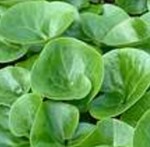 European wild ginger is a low growing evergreen herbaceous perennial native to the of forests and woodlands of eastern Europe and western Asia. It belongs to the pipevine family, Aristolochiaceae, and is not related to true ginger in spite of its common name that it acquired because its rhizomes taste and smell like ginger root when crushed or bruised. The heart-shaped, dark green leaves are two to three inches wide, glossy and leathery, and may be slightly mottled. They are produced in pairs on petioles five to six inches long on prostrate stems. The inconspicuous greenish-brown flowers are solitary, urn-shaped and nodding. They appear in late winter to early summer but are usually hidden by the leaves. The rhizomes of European wild ginger grow slowly to form dense mats of leaves creating an excellent ground cover in shady cool areas. Unfortunately, it does not do well in the heat and humidity of the South.
European wild ginger is a low growing evergreen herbaceous perennial native to the of forests and woodlands of eastern Europe and western Asia. It belongs to the pipevine family, Aristolochiaceae, and is not related to true ginger in spite of its common name that it acquired because its rhizomes taste and smell like ginger root when crushed or bruised. The heart-shaped, dark green leaves are two to three inches wide, glossy and leathery, and may be slightly mottled. They are produced in pairs on petioles five to six inches long on prostrate stems. The inconspicuous greenish-brown flowers are solitary, urn-shaped and nodding. They appear in late winter to early summer but are usually hidden by the leaves. The rhizomes of European wild ginger grow slowly to form dense mats of leaves creating an excellent ground cover in shady cool areas. Unfortunately, it does not do well in the heat and humidity of the South.
Type: Evergreen herbaceous perennial
Bloom: Inconspicuous greenish-brown, solitary, urn-shaped, nodding. Flowers in late winter to early summer.
Size: 4-6” H x 8-12” W
Light: Part shade to full shade
Soil: Average, consistently moist, well-drained, slightly acidic
Hardiness: Zones 4-7
Care: Low maintenance
Pests and Diseases: Generally healthy but susceptible to slugs, snails, and rust.
Propagation: Seed, division in spring or fall
Companion plants: Ferns, hosta, trillium, foamflowers, crocus, squill, astilbe, wild blue phlox, sweet woodruff, bleeding heart, epimedium